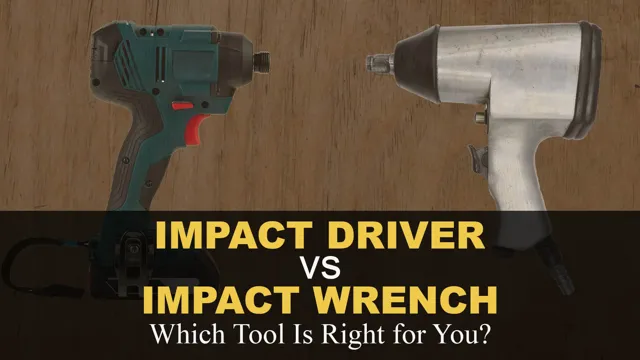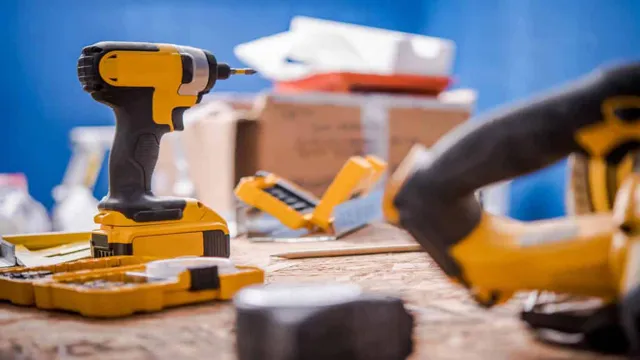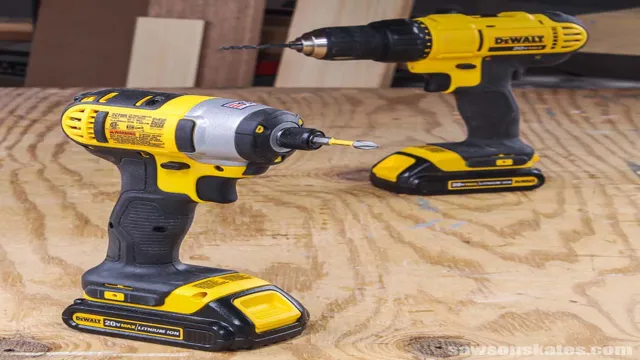Can an Impact Driver be Used as an Impact Wrench? Exploring the Differences and Similarities

Have you ever found yourself in a situation where you needed to remove or tighten a bolt but didn’t have the proper tool at hand? Even if you’re not a professional mechanic, it’s essential to have a set of versatile tools in your toolbox that can help you out in a pinch. This is where the confusion between impact drivers and impact wrenches can arise – are they interchangeable? Can you use one in place of the other? In this blog post, we’ll answer the question: Can an impact driver be used as an impact wrench? Let’s explore the differences between the two and whether an impact driver can be used as a substitute.
Difference Between an Impact Driver and Impact Wrench
Many people wonder if an impact driver can be used as an impact wrench. While they may look similar, these two tools serve different purposes. An impact driver is designed to drive screws and small fasteners, making it a great option for DIY projects and general use.
On the other hand, an impact wrench is designed specifically for loosening and tightening nuts and bolts in automotive and machinery applications. It can handle larger screw sizes and has a higher torque output. While an impact driver may be able to loosen or tighten a few smaller bolts, it will not be as effective or efficient as an impact wrench.
So to answer the question, no, an impact driver cannot fully replace an impact wrench. However, both tools serve important purposes and can be valuable additions to any tool collection.
Impact Driver
An impact driver and an impact wrench are both powerful tools, but they serve different purposes. An impact driver is primarily used for driving screws and other fasteners quickly and efficiently. It delivers rotational force to the screw with high speed and high torque, making it ideal for tough jobs such as installing decking or building furniture.
On the other hand, an impact wrench is designed for heavy-duty tasks such as loosening and tightening bolts or nuts. It delivers a strong twisting motion and is commonly used in automotive repair and construction settings. So while both tools feature the same impact mechanism, their applications are quite different.
If you’re unsure which tool you need, consider the task at hand and choose the tool that’s best suited for the job. Remember, using the right tool for the job can save you time and effort.

Impact Wrench
An impact driver and impact wrench are often confused with each other, but they actually have different functions. While an impact driver is used for tasks such as drilling holes and driving screws, an impact wrench is specifically designed to loosen or tighten bolts and nuts. Impact wrenches are incredibly powerful tools that use rotational force to quickly remove or tighten fasteners, making them a staple in automotive and mechanical work.
On the other hand, impact drivers are better suited for lighter tasks where precision is key. So, if you’re looking to tackle a project that involves dealing with stubborn bolts, an impact wrench is most likely the tool you need. Remember: impact wrenches are not just more powerful than impact drivers, they are also designed for a specific set of tasks.
Torque and RPM
When it comes to torque and RPM, both are crucial factors to consider when deciding between an impact driver and impact wrench. An impact driver is designed with lower torque and RPM, making it ideal for lighter tasks such as assembling furniture or installing small hardware. Whereas an impact wrench has a higher torque and RPM, making it suitable for more heavy-duty tasks such as automotive repairs or construction work.
Think of it like using a regular screwdriver instead of a power drill. The screwdriver may be suitable for small tasks, but for larger jobs, the power drill will get the job done much quicker and more efficiently. Ultimately, it comes down to what tasks you need to accomplish and what kind of power tool will help you get it done with ease and efficiency.
Using an Impact Driver as an Impact Wrench
Many people wonder if an impact driver can also be used as an impact wrench. While they may look similar, there are some differences between the two tools. An impact driver is designed for driving screws and bolts into various materials.
It generates a rotational force and helps to prevent stripping of the screws. On the other hand, an impact wrench is designed for tightening and loosening nuts and bolts, typically with a square drive. It exerts a high amount of torque to break free stubborn bolts and nuts.
Can an impact driver be used as an impact wrench? Yes, it is possible to use an impact driver to loosen or tighten nuts and bolts, provided that it has an adapter that allows for a square drive bit to be attached. However, it is not designed to handle the high torque required for large bolts and nuts, so it may not be suitable for heavy-duty applications. In addition, impact drivers typically have a lower RPM than impact wrenches, so they may not be as efficient at removing or tightening bolts.
In conclusion, while an impact driver can technically be used as an impact wrench with the right adapter, it is not recommended for heavy-duty applications. If you need to tighten or loosen large bolts and nuts, it is best to invest in a dedicated impact wrench. However, if you only need to occasionally work with smaller bolts and screws, an impact driver with square drive adapter can be a useful addition to your arsenal of tools.
Compatibility
Impact driver, Impact wrench, Compatibility If you’ve ever found yourself in need of tightening or loosening nuts and bolts, you may have wondered whether an impact driver can be used as an impact wrench. The answer is yes, albeit with some limitations. Impact drivers and impact wrenches have similar functions, but there are some key differences in terms of power and compatibility.
Impact wrenches are typically more powerful, making them better suited for heavy-duty tasks. That being said, impact drivers can still be used for lighter tasks and can work well with smaller nuts and bolts. Just be sure to check the compatibility of your impact driver before using it as an impact wrench, as it may not be suitable for all tasks.
Overall, while an impact driver can be used as an impact wrench in some cases, for heavy-duty tasks and larger nuts and bolts, an impact wrench may be the better option.
Torque Requirements
Torque Requirements, Impact Driver, Impact Wrench If you’ve ever had to work on a stubborn nut or bolt, you know the importance of having the right tool to get the job done. Impact drivers and impact wrenches are two tools that can provide the power needed to tackle tough jobs, but it’s important to understand their differences and when to use each tool. While an impact driver is designed for driving screws and bolts, it can also be used as an impact wrench to loosen and tighten nuts and bolts.
However, it’s important to keep in mind that an impact driver may not provide enough torque for larger bolts or stubborn nuts. For those jobs, an impact wrench is the better option. When using an impact driver as an impact wrench, it’s important to match the tool’s torque to the requirements of the job.
Too little torque and the bolt may not be secured properly, too much torque and you risk damaging the bolt or nut. So, when deciding between an impact driver and an impact wrench, consider the torque requirements of the job at hand.
Impact Socket
Impact Socket, Impact Driver, Impact Wrench So you’ve got an impact driver and you’re wondering if it can also function as an impact wrench. The answer? It depends. While impact wrenches and impact drivers may look similar and share some overlapping features, they serve different purposes.
Impact wrenches are designed to loosen and tighten bolts and nuts with high torque, while impact drivers are meant for fastening screws and drilling holes. However, if you have the right kind of impact socket, you can use your impact driver as an impact wrench. Impact sockets are designed to handle the high torque of an impact tool and offer a secure grip on fasteners.
Just make sure to use the correct size and type of impact socket for the job to avoid damaging your tools or the fasteners you’re working on. With the right tools and precautions, you can make use of your impact driver in a variety of DIY and professional projects.
Pros and Cons of Using an Impact Driver as an Impact Wrench
If you’re wondering if an impact driver can be used as an impact wrench, the short answer is yes. However, it’s important to understand the pros and cons of doing so. An impact driver can produce a high amount of torque and can be useful for driving screws and bolts, but it may not have the same power and control as an impact wrench.
Impact wrenches are specifically designed for tightening and loosening nuts and bolts quickly and efficiently, while impact drivers are more versatile and can be used for a variety of tasks. Impact drivers are also typically smaller and more compact, making them easier to use in tight spaces. However, if you need to tighten or loosen large bolts or nuts, an impact wrench may be a better option as it can provide the necessary power and precision.
Ultimately, the decision to use an impact driver as an impact wrench will depend on the specific task at hand and the tools available.
Pros
When it comes to the pros of using an impact driver as an impact wrench, there are a number of benefits to consider. One of the biggest advantages is that an impact driver is typically much more compact and lightweight than an impact wrench, making it easier to maneuver in tight spaces or overhead. Additionally, impact drivers often have higher speeds and more torque than traditional drills, allowing for more efficient and effective fastening.
Impact drivers are also typically less expensive than impact wrenches, making them a more cost-effective option for DIYers and casual users. Finally, impact drivers often allow for quick and easy bit changes, making them a more versatile tool overall. All of these factors can make an impact driver a great option for those looking for a powerful and efficient tool for home improvement projects, automotive work, or other tasks that require fastening and loosening bolts and screws.
Cons
When it comes to using an impact driver as an impact wrench, there are definitely some pros and cons to consider. One major pro is that impact drivers are often much smaller and lighter than impact wrenches, which can make them easier to maneuver in tight spaces or for extended periods of time. Additionally, impact drivers often have more torque than standard cordless drills, so they can still pack a decent punch when it comes to loosening or tightening bolts and screws.
However, there are also some cons to using an impact driver in this way. For one thing, impact drivers may not be strong enough to handle very large or stubborn bolts, which means you might need to invest in an impact wrench or other tool for heavier-duty jobs. Additionally, using an impact driver as an impact wrench could cause damage to the tool over time, as they weren’t necessarily designed to handle the same level of strain and pressure.
Ultimately, whether or not you choose to use an impact driver as an impact wrench will depend on your specific needs and preferences, but it’s always a good idea to consider the pros and cons before making any decisions.
Conclusion
While an impact driver and an impact wrench may seem similar in name and function, they are designed for different tasks. An impact driver is best suited for driving screws and fasteners with precision and control, while an impact wrench is designed for heavy-duty tasks like removing lug nuts and tightening bolts on machinery. So while you could use an impact driver as an impact wrench in a pinch, it’s like trying to use a butter knife to cut down a tree – it’s not the right tool for the job.
Ultimately, it’s always best to use the right tool for the job to ensure efficiency, safety, and prevent unnecessary wear and tear.”
FAQs
What is the difference between an impact driver and an impact wrench?
While both tools use rotational force to drive screws or bolts, an impact driver is designed for smaller fasteners and has a higher rotational speed, while an impact wrench is designed for larger bolts and has higher torque.
Can an impact driver be used as an impact wrench?
No, an impact driver cannot be used as an impact wrench. The two tools have different strengths and are designed for different types of fasteners.
What are the advantages of using an impact wrench over a regular wrench?
An impact wrench provides more torque, making it easier to tighten or loosen stubborn bolts or nuts. It also saves time and effort compared to using a regular wrench.
Can an impact wrench be used on Lug nuts?
Yes, an impact wrench can be used on lug nuts. In fact, it’s one of the most common uses for an impact wrench.
Is it necessary to use a special socket with an impact wrench?
Yes, it is necessary to use a special socket with an impact wrench. Standard sockets can break or shatter under the high torque of an impact wrench.
Can an impact wrench be used for automotive work?
Yes, an impact wrench is commonly used for automotive work, such as changing tires or working on the engine.
What should I consider when buying an impact wrench?
When buying an impact wrench, consider factors such as the power source (electric or air), the torque output, and the size and weight of the tool. It’s also important to consider the types of fasteners you’ll be working with.



